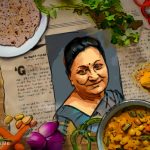Gastronomy and power: India’s daily bread
From tales of good demons to the quirks of bunny chow fillings and ordering beef in Bangalore, there are many ways to stick it to the Brahmins and the BJP in India.
Author:
13 December 2019

Football, beers and bunny chows. What could possibly go wrong? Well… the football was between the Red Mancs and the Red Scousers, whose fans are notoriously insufferable even well past midnight, in Yes, Minister, a Delhi pub that sounded too close to Narendra Modi sycophancy.
Then there were the crimes against the bunnies, which had fillings such as bhaji (a spicy blend of mashed vegetables) and peas; pepperoni, sausage, mozzarella, parmesan shavings and egg; and spinach, ricotta and corn.
“How dare they culturally appropriate us?” writer and bunny purist Pravasan Pillay responded when sent a photograph of the menu, tongue firmly in a mutton bone filled with marrow. “Damn, those are some shit fillings,” he followed up, adding a green vomiting emoji.
Even in India, where one would assume the curry retains a semblance of regard, the hipster gentrification of the bunny chow had not been averted. From lamb meatballs in a monkeygland sauce served inside a sourdough loaf in London to celebrity chef Reza Mahammad’s brioche duck bunny chow recipes, the humble Durban street food has suffered more atrocities perpetrated in its name than India’s various deities.
Okay, “hanger” may lead to hyperbole, only just, but the bunny is a simple concept: Curry, which Indians do well. Bread, which Indians do well. Hollow out the bread. Add the curry filling, replace the plug. Aur yah baat hai! Et voilà!
But there was no mutton curry with rich, red-brown gravy soaking into processed white bread, turning it into the “gelatinous-like hybrid of curry and bread” that Pillay describes so evocatively in his writing. No broad bean or sugar bean curries with their thick gravies and comforting double hit of protein and starch that demands a postprandial snooze – “python time”, as photographer Rafs Mayet often describes it.

Instead of innovation, this was just another violation of a simple street food with a pumped up price (ranging from 450 to 650 Indian rupees, about R100 to R135) to feed a fad rather than a stomach. This violence against working people’s food is often perpetrated by hipster “artisans” who care much less about food and drink and much more about the cash they can extract from the middle and upper classes keen to pay for a frisson of “edginess” that these reinterpretations presumably induce in their dopamine pathways.
A mainstreaming that entrenches class and race divides in urban South Africa and removes the need to actually get down to an “uncle and aunty’s” curry or Gatsby joint, or to the actual street to taste what the stalls offer; from tripe cooked on gas burners to bovine heads boiled in metal drums and served with raw chillies, salt and pap.
Gin and its reasoning
The pseudo-artisanal and hipster approach to food is cynically capitalist in nature, the current obsessions with gin being a case in point. Instead of working with traditional South African drinks such as mampoer, distillers have merely reproduced trends from the United States and Britain.
For gin, the reasoning is simple and cutthroat. The liquor takes much less time to make (a few days) compared with the weeks for a mampoer to be made with local peaches, prickly pear or marula; or the minimum of five years you would need to start making premium local whisky with grain from the Free State and water from the Lesotho highlands. This gin trend represents voracious globalised monoculture rather than locality-specific artisanship.
Related article:
But innovation – even in humanity’s worst moments, like colonialism or late capitalism – remains essential to food.
The Portuguese invaded Goa on India’s southwest coast in 1510. By 1560, after the establishment of the Goa Inquisition, large-scale persecution of Muslims, Hindus and other religious minorities was the norm. Goa remained under Portuguese control for almost 15 years after India’s independence in 1947, finally becoming a union territory when the Indian army invaded and annexed the area following a 36-hour battle in 1961. In 1987 it became a fully fledged state.
The Portuguese influence is clear in the food: the fatty, spicy pork chorizo sausages are a speciality of the region. They are served straight up or with a quick fry in tomatoes, onions, chilli, garlic and a sprinkle of dhania (coriander), sometimes calamari as well.
A modern fusion of Portuguese and Indian gastronomic cultures is the sausage bread (80 Indian rupees, about R18): chorizo chopped and broken up, cooked in sauce and folded into naan bread, which is then baked quickly in a tandoor oven. At Johnceys, one of the few beachfront restaurants in Sernabatim in south Goa that debunks the rule of thumb that the better the view, the worse the food, the waiters could not trace the delicious bread’s history and could only approximate it as three or so decades old.
But washed down with some feni, a liquor made from cashew nuts, it is a sumptuous snack.
Politics of eating
Eating can be a political act in India, especially with the Hindu nationalist Bharatiya Janata Party (BJP) using the ban on killing or eating the “holy cow” as a mob incitement tool against Muslims and Muslim-owned butcheries.
So, sitting across from historian and author Ramachandra Guha at Sunny’s, one of Bangalore’s first fine dining restaurants, ordering a medium rare beef steak seemed the subversive thing to do. The convivial lunch was to be spent discussing cricket, the rising ethno-fascism in India and why South African cricketer Jacques Kallis was a better batsman than India’s Sachin Tendulkar.
At the time, Guha, as well as filmmakers Aparna Sen and Mani Ratnam, and 46 other high-profile Indians were facing farcical charges of sedition. This was in response to an open letter they had written to Prime Minister Modi expressing their concern about the increase in mob lynchings, especially in BJP-controlled states. The charges were eventually dropped.

The BJP was also pushing for a beef ban in Karnataka, the state of which Bangalore is the capital. It is considered a historically cosmopolitan and progressive city.
Staggering out of Sunny’s and winding past excellent bookstores such as Blossom Book House, one can end up at Koshy’s Parade Café, which attracts Bangalore’s artistic, creative and political types. Under its high ceilings, old men hold serious discussions about the state of the nation and students pore over books while eating reasonably priced meals.
Good gods, bad demons
India’s south has a more potent history of subversion than merely chewing on the holy cow in Bangalore. The ancient story of Mahabali in Kerala – a long time Marxist-controlled state – is instructive for its sabotaging of the reductive dichotomy of good gods and bad demons, of race and skin colour, and for undercutting the Brahminic stranglehold on the religion and its interpretations.
Mahabali was apparently a much-loved Daitya king during whose reign there was no discrimination along class or caste lines. The Devas, the various heavenly deities of Hindu scripture, had grown jealous of Mahabali and convinced Lord Vishnu to end his rule.
According to the traditional tale, Vishnu adopted the avatar of Vamana – a child or dwarf, depending on who is telling the story – and approached the king asking for a gift of three feet of land.
Related article:
Mahabali complied, at which point Vamana grew into a giant so large that he measured out the earth with one step and the universe with his second. Or so the story goes. Realising Vamana was actually Vishnu, Mahabali placed his head under the god’s foot, thus sending himself to the underworld. He had one wish, though: to have the energy each year to visit his people during what would become the festival of Onam.
Mahabelly is a Delhi restaurant that riffs off the legend of the good demon for its name and Kerala’s seafood-based cuisine for its menu. They do Kerala staples such as Kothu parotta (shredded Malabar parotta egg, chicken, meat and rice dish erachi or mutton); fish fry, which is masala-rubbed fish (anchovies, pearl spot, seer, sardines or mackerel) that is pan-fried; excellent Shappu Meen curry: fish cooked with tamarind to make a gorgeous, dark red dish; and prawns in a hot tomato sauce with curry leaves and spices, cooked in a banana leaf.
The food is heavenly, or demonically great, depending on how you like your Hinduism rehashed.
In India, though, the rehashing of Hinduism for the BJP’s narrow ethno-nationalism cloaks the party’s capitalist drive to reclaim the economy for its coterie of politically connected families, tenderpreneurs and financial backers. Among the hipsters and middle classes who aspire to the 1%, they have willing handmaidens.


